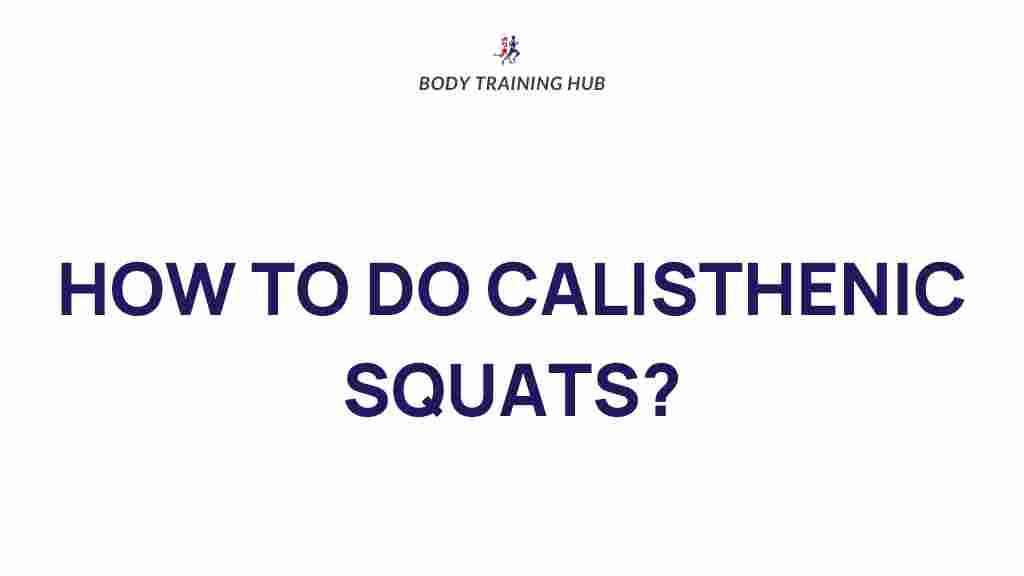Unleash Your Strength with Calisthenic Squats
Calisthenics is a form of strength training that utilizes the weight of your own body to build muscle, improve flexibility, and enhance overall fitness. Among the various bodyweight exercises, squats stand out as a fundamental movement that not only strengthens the lower body but also engages the core and promotes balance. In this article, we will explore the benefits of calisthenic squats, provide a step-by-step guide on how to perform them correctly, troubleshoot common issues, and offer tips for maximizing your strength training and muscle building.
The Benefits of Calisthenic Squats
Calisthenic squats are an excellent addition to any workout routine. Here are some of the key benefits:
- Builds Lower Body Strength: Squats primarily target the quadriceps, hamstrings, and gluteal muscles.
- Enhances Core Stability: Performing squats engages the core, improving overall stability and strength.
- Increases Flexibility: Regularly performing squats can enhance flexibility in the hips, knees, and ankles.
- Boosts Functional Fitness: Squats mimic everyday movements, making them essential for functional strength.
- Improves Posture: Strengthening the lower body and core can lead to better posture.
How to Perform Calisthenic Squats
Performing calisthenic squats correctly is crucial for maximizing benefits and minimizing the risk of injury. Follow these steps for the perfect squat:
- Prepare Your Stance: Stand with your feet shoulder-width apart. Your toes should point slightly outward.
- Engage Your Core: Tighten your abdominal muscles to stabilize your core.
- Initiate the Squat: Begin by bending your knees and pushing your hips back as if you are sitting in a chair.
- Lower Your Body: Keep your chest up and back straight as you lower your body. Aim to bring your thighs parallel to the ground.
- Maintain Proper Form: Ensure your knees do not go beyond your toes and that your weight is in your heels.
- Return to Starting Position: Press through your heels and straighten your legs to return to the starting position.
Repeat this movement for 10-15 repetitions, ensuring to maintain good form throughout the exercise.
Incorporating Calisthenic Squats into Your Routine
Calisthenic squats can be incorporated into various workout routines. Here are some ideas:
- Warm-Up: Use squats as part of your warm-up routine to prepare your muscles.
- Strength Training: Combine squats with other bodyweight exercises like push-ups, lunges, and planks.
- High-Intensity Workouts: Integrate squats into circuit training for a high-intensity workout.
Common Mistakes and Troubleshooting Tips
Even though squats are a basic exercise, many people make mistakes that can lead to ineffective workouts or injury. Here are some common issues and how to fix them:
- Knees Collapsing Inward: Ensure your knees track over your toes. Strengthen your hip abductors to improve stability.
- Leaning Forward: Keep your chest up and shoulders back. Engaging your core can help maintain an upright posture.
- Not Going Low Enough: Aim for thighs parallel to the ground. Use a mirror to check your depth if necessary.
- Rounding the Back: Maintain a neutral spine throughout the movement. Focus on keeping your back straight by engaging your core.
If you face difficulties, consider seeking professional guidance or watching instructional videos for visual aid.
Progressing Your Calisthenic Squats
Once you master the basic squat, you can progress to more challenging variations to enhance your strength training and muscle building:
- Jump Squats: Add a jump at the peak of your squat for explosive power.
- Pistol Squats: Perform a single-leg squat for increased difficulty.
- Squat Holds: Hold the squat position for a set time to build endurance.
- Weighted Squats: Use a backpack with weights or resistance bands to increase intensity.
Conclusion
Calisthenic squats are an essential component of any strength training routine. They offer numerous benefits, from building lower body strength to improving core stability. By following the proper techniques, troubleshooting common mistakes, and gradually progressing to more advanced variations, you can unleash your strength and enhance your muscle-building efforts through this powerful bodyweight exercise.
For more information on bodyweight exercises, check out this helpful resource on effective calisthenics workouts. And don’t forget, consistency is key to achieving your fitness goals!
This article is in the category Strength & Recovery and created by BodyTraining Team
